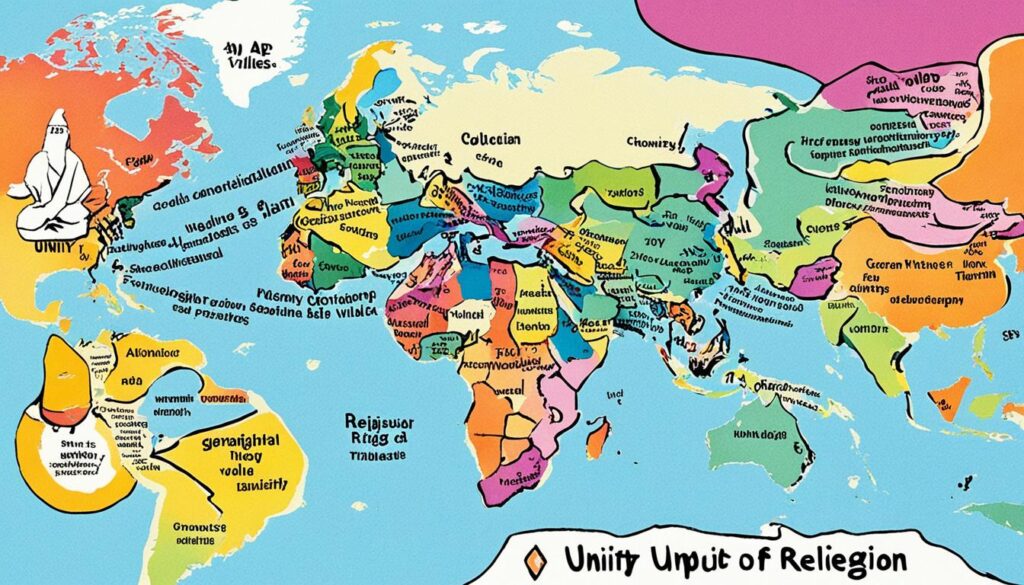Have you ever wondered how religions can transcend cultural and geographical boundaries, uniting people across the world under a shared set of beliefs? How do universalizing religions, such as Christianity, Islam, Buddhism, and Sikhism, spread their teachings to all corners of the globe? In this article, we will explore the characteristics and examples of universalizing religions, as well as their impact on human geography.
Key Takeaways:
- Universalizing religions aim to be universally applicable to all people, regardless of their background.
- They emphasize individual spirituality and personal salvation or enlightenment.
- Examples of universalizing religions include Christianity, Islam, Buddhism, and Sikhism.
- These religions spread through various means, including trade, migration, conquest, and missionary work.
- Studying universalizing religions in AP Human Geography helps us understand the role of religion in shaping societies and cultural landscapes.
Characteristics of Universalizing Religions
Universalizing religions are religions that are meant to be universally applicable to all people. They believe in absolute religious truth and often see themselves as the only true religion. They typically have specific founders and place a strong emphasis on personal salvation or enlightenment. Universalizing religions also tend to have a strong missionary tradition, spreading their beliefs and teachings globally.
These characteristics distinguish universalizing religions from other types of religions. While some religions are specific to certain groups or regions, universalizing religions strive to transcend boundaries and reach a global audience. They aim to offer a path to spiritual fulfillment and enlightenment to all individuals, regardless of their background or geographical location.
Belief in Absolute Religious Truth
One defining characteristic of universalizing religions is their belief in absolute religious truth. They assert that their teachings, doctrines, and practices represent the ultimate and absolute understanding of divinity and spiritual enlightenment. They often view themselves as the only true religion, emphasizing the exclusivity of their faith.
This belief in absolute truth guides the principles and practices of universalizing religions. It provides a foundation for their missionary efforts and a motivation to spread their message to as many people as possible.
Founder and Historical Context
Universalizing religions typically have specific founders who shape their teachings and beliefs. These founders play a crucial role in establishing the core principles and practices of the faith. Examples include Jesus Christ in Christianity, Prophet Muhammad in Islam, Siddhartha Gautama (Buddha) in Buddhism, and Guru Nanak Dev Ji in Sikhism.
The historical context in which these religions emerged also influences their characteristics. For example, the socio-political environment of ancient Israel shaped the development of Christianity, while the Arabian Peninsula’s cultural and religious diversity influenced the early formation of Islam.
Emphasis on Personal Salvation or Enlightenment
Universalizing religions place a strong emphasis on personal salvation or enlightenment. They offer individuals a path to achieve spiritual fulfillment and transcendence through rituals, practices, and adherence to religious teachings. The ultimate goal is to attain salvation, eternal life, or liberation from the cycle of rebirth.
Personal spiritual growth and self-transformation are central to the beliefs and practices of universalizing religions. Followers are encouraged to engage in prayer, meditation, self-discipline, and acts of compassion to cultivate a deep connection with the divine and achieve enlightenment.
Missionary Tradition
Universalizing religions have a long-standing tradition of missionary work. They actively seek to spread their beliefs and teachings to people around the world. Whether through direct evangelization, educational initiatives, or humanitarian efforts, universalizing religions aim to reach a global audience and increase their number of followers.
This missionary tradition has contributed to the global presence of universalizing religions. It has led to the establishment of religious institutions, the translation of sacred texts into various languages, and the adaptation of religious practices to suit different cultural contexts.
| Characteristics of Universalizing Religions |
|---|
| Belief in absolute religious truth |
| Founded by specific individuals |
| Emphasis on personal salvation or enlightenment |
| Missionary tradition |

Examples of Universalizing Religions
Universalizing religions are religions that strive to be universally applicable to all people, transcending cultural and geographic boundaries. These religions have followers around the world and share a common goal of spreading their beliefs to all individuals, irrespective of their backgrounds. Below are some prominent examples of universalizing religions:
1. Christianity
Christianity is the largest universalizing religion globally, with over 2.3 billion followers. It originated in the 1st century CE in the eastern Mediterranean and spread through missionary work and colonialism. Christianity is centered around the teachings of Jesus Christ and encompasses various denominations, including Catholicism, Protestantism, and Eastern Orthodoxy.
2. Islam
Islam is the second-largest universalizing religion, with approximately 1.8 billion adherents. It emerged in the 7th century CE in the Arabian Peninsula through the teachings of Prophet Muhammad. Islam emphasizes the belief in one God (Allah) and incorporates the pillars of faith, including prayer, fasting, charity, pilgrimage, and the declaration of faith (Shahada).
3. Buddhism
Buddhism originated in India during the 5th century BCE and is based on the teachings of Siddhartha Gautama, also known as the Buddha. With around 535 million practitioners worldwide, Buddhism focuses on the Four Noble Truths, which explore the nature of suffering, and the Eightfold Path, which guides individuals towards enlightenment. Buddhism promotes meditation, compassion, and the pursuit of inner peace.
4. Sikhism
Sikhism, founded in the 15th century CE in Punjab, India, is a monotheistic religion with approximately 30 million adherents. It centers around the teachings of Guru Nanak Dev Ji and emphasizes unity with God and equality among all individuals. Sikhism promotes honest living, community service, and the importance of selfless devotion to God.
To better visualize the global distribution of universalizing religions, refer to the following table:
| Religion | Number of Followers | Main Geographical Regions |
|---|---|---|
| Christianity | Approximately 2.3 billion | North America, Europe, Latin America, Africa |
| Islam | Approximately 1.8 billion | Middle East, Africa, Asia |
| Buddhism | Approximately 535 million | East Asia, Southeast Asia, South Asia |
| Sikhism | Approximately 30 million | India, Canada, United Kingdom |
Understanding the diversity of universalizing religions and their impact on societies worldwide provides valuable insights into the interconnectedness of human cultures and the pursuit of spiritual fulfillment across geographies.

Spread of Universalizing Religions
Universalizing religions have spread across the world through various means, including trade, migration, conquest, and missionary work. These religions transcend geographical boundaries and connect people from diverse cultures and backgrounds under a shared belief system.
Christianity, one of the largest universalizing religions, experienced significant growth through European colonialism. The influence of colonial powers helped spread Christianity to different parts of the world, including the Americas, Africa, and Oceania.
Islam, another major universalizing religion, expanded through a combination of conquest and trade networks. Muslim armies conquered vast territories in the Middle East, Africa, and Asia, leading to the conversion of many communities to Islam. The extensive trade networks established by Islamic merchants facilitated the spread of the religion across continents.

Buddhism’s spread occurred through trade routes and the influence of emperors. As merchants traveled along the Silk Road, they carried Buddhist teachings and practices to regions as far as Southeast Asia. Emperors, such as Ashoka in ancient India, played a crucial role in promoting Buddhism by embracing the religion and supporting its propagation.
Sikhism, a relatively newer universalizing religion, spread through the teachings of its founder, Guru Nanak, and the dedication of its followers. Sikhism was established in Punjab, India, and its principles of equality and devotion to God resonated with many individuals. The Sikh diaspora, driven by economic opportunities and persecution, further contributed to the global spread of Sikhism.
The remarkable spread of universalizing religions highlights the impact of human agency, cultural exchange, and historical events on the diffusion of religious beliefs. As these religions continue to evolve and adapt to new contexts, they shape the cultural landscape and contribute to the diversity of human experiences worldwide.
AP Human Geography Religious Geography
In the field of AP Human Geography, the study of religious geography serves as a crucial component for understanding the complex dynamics that shape our societies and communities. By analyzing the spatial patterns and distribution of religions, as well as their impact on cultural landscapes and human connections, we gain valuable insights into the role of religion in shaping our world.
Religious geography explores various aspects related to religion, including:
- The influence of religion on migration patterns, both historically and in modern times.
- The role of religion in conflicts and the formation of societal divisions.
- The impact of religious practices on cultural traditions and customs.
Studying religious geography allows us to gain a deeper understanding of how diverse religious beliefs and practices shape societies across the globe.
Through the AP Human Geography religion unit, students have the opportunity to delve into the intricate relationships between religion and geographic space. By examining the distribution and concentration of religions, students can analyze how religious communities interact with their physical environments and how these interactions influence cultural development.
AP Human Geography religion notes may include concepts such as:
- Patterns of religious diffusion and the spread of religious ideas.
- The impact of religious beliefs on land use and the formation of sacred spaces.
- Religious landscapes and the manifestation of religious symbolism in architecture, art, and rituals.
By exploring these aspects, students develop a comprehensive understanding of the interactions between religion, culture, and geography, equipping them with valuable knowledge and insights into the complexities of our world.

Religious geography is a fascinating field of study that sheds light on the intricate relationship between religion and the human experience. Understanding the spatial and cultural dimensions of religion enables us to appreciate the diversity and interconnectedness of human societies, fostering a deeper sense of unity and empathy in our increasingly globalized world.
Buddhism’s Impact on Personal and Societal Harmony
Buddhism has had a profound impact on individuals and society, offering teachings that promote mindfulness, compassion, and the pursuit of harmony in our modern world. Through its principles and practices, Buddhism addresses the challenges we face in our daily lives, guiding us towards personal growth and the betterment of society.
Mindfulness is a central aspect of Buddhism, emphasizing the importance of being fully present in the moment and cultivating awareness of our thoughts, emotions, and actions. By practicing mindfulness, we can develop a deeper understanding of ourselves and the world around us, leading to clarity, peace, and improved mental well-being.
Compassion is another core value in Buddhism, encouraging us to extend kindness, empathy, and understanding to all beings. Through acts of compassion, we foster positive relationships, enhance our connection with others, and promote a sense of unity and cooperation in our communities.
Buddhism also offers ethical guidelines that address the modern challenges we face, such as sustainability and social justice. The teachings of Buddhism encourage us to live in harmony with nature, promoting environmental stewardship and ensuring the well-being of future generations. Additionally, Buddhism advocates for equality and social inclusivity, emphasizing the importance of treating all individuals with respect and dignity.
By integrating the teachings of Buddhism into our lives, we can navigate the complexities of the modern world with greater clarity, compassion, and wisdom. Buddhism provides a path toward personal and societal transformation, guiding us to live harmoniously and make positive contributions to our communities.
Conclusion
Universalizing religions, such as Christianity, Islam, Buddhism, and Sikhism, play a crucial role in shaping cultural landscapes and fostering human connections. These religions go beyond boundaries, bringing people from diverse backgrounds together under a shared set of beliefs and values.
Studying universalizing religions in AP Human Geography provides valuable insights into how religions shape societies, influence migration patterns, and impact cultural practices. By understanding the characteristics and spread of universalizing religions, we gain a deeper appreciation for the diversity and interconnectedness of human cultures.
Universalizing religions have the power to transform landscapes, both physical and social, as they leave their mark through religious architecture, pilgrimage sites, and rituals. These religious practices not only define cultural spaces but also create strong human connections as believers gather to worship, celebrate, and seek spiritual guidance.
Moreover, universalizing religions often drive changes in migration patterns, as they encourage followers to spread their beliefs through missionary work or seek refuge in regions where their religion is prevalent. This movement of people fosters cultural exchange, as different communities come into contact and influence one another, resulting in a richer and more diverse global society.
FAQ
What are universalizing religions?
Universalizing religions are religions that aim to be universally applicable to all people, regardless of race, ethnicity, culture, or geographic location. They are designed to cross ethnic and national boundaries and often place a greater emphasis on individual spirituality.
What are the characteristics of universalizing religions?
Universalizing religions typically believe in absolute religious truth and often see themselves as the only true religion. They have specific founders and place a strong emphasis on personal salvation or enlightenment. They also tend to have a strong missionary tradition, spreading their beliefs and teachings globally.
Can you provide examples of universalizing religions?
Examples of universalizing religions include Christianity, Islam, Buddhism, and Sikhism.
How do universalizing religions spread?
Universalizing religions have spread through various means, including trade, migration, conquest, and missionary work. The spread of Christianity was facilitated by European colonialism, while Islam spread through conquest and trade networks. Buddhism spread through trade routes and the influence of emperors, and Sikhism spread through the teachings of its founder and the adherence to its principles by its followers.
What is the relevance of universalizing religions in AP Human Geography?
In AP Human Geography, the study of religious geography examines the spatial patterns and distribution of religions, as well as their impact on cultural landscapes and human connections. Understanding the characteristics and spread of universalizing religions helps students appreciate the diversity and interconnectedness of human cultures.
What impact does Buddhism have on personal and societal harmony?
Buddhism offers teachings that promote mindfulness, compassion, and the pursuit of personal and societal harmony. Its emphasis on introspection and self-awareness helps individuals cultivate inner peace and mental well-being. Buddhism also provides ethical guidelines that address modern challenges and promote sustainability, social justice, and the alleviation of suffering in the world.
What is the significance of universalizing religions in shaping cultural landscapes and fostering human connections?
Universalizing religions transcend boundaries and unite people from different backgrounds under a shared set of beliefs and values. They play a significant role in shaping cultural landscapes and fostering human connections. Studying universalizing religions in AP Human Geography provides insights into the ways in which religions shape societies, influence migration patterns, and impact cultural practices.

